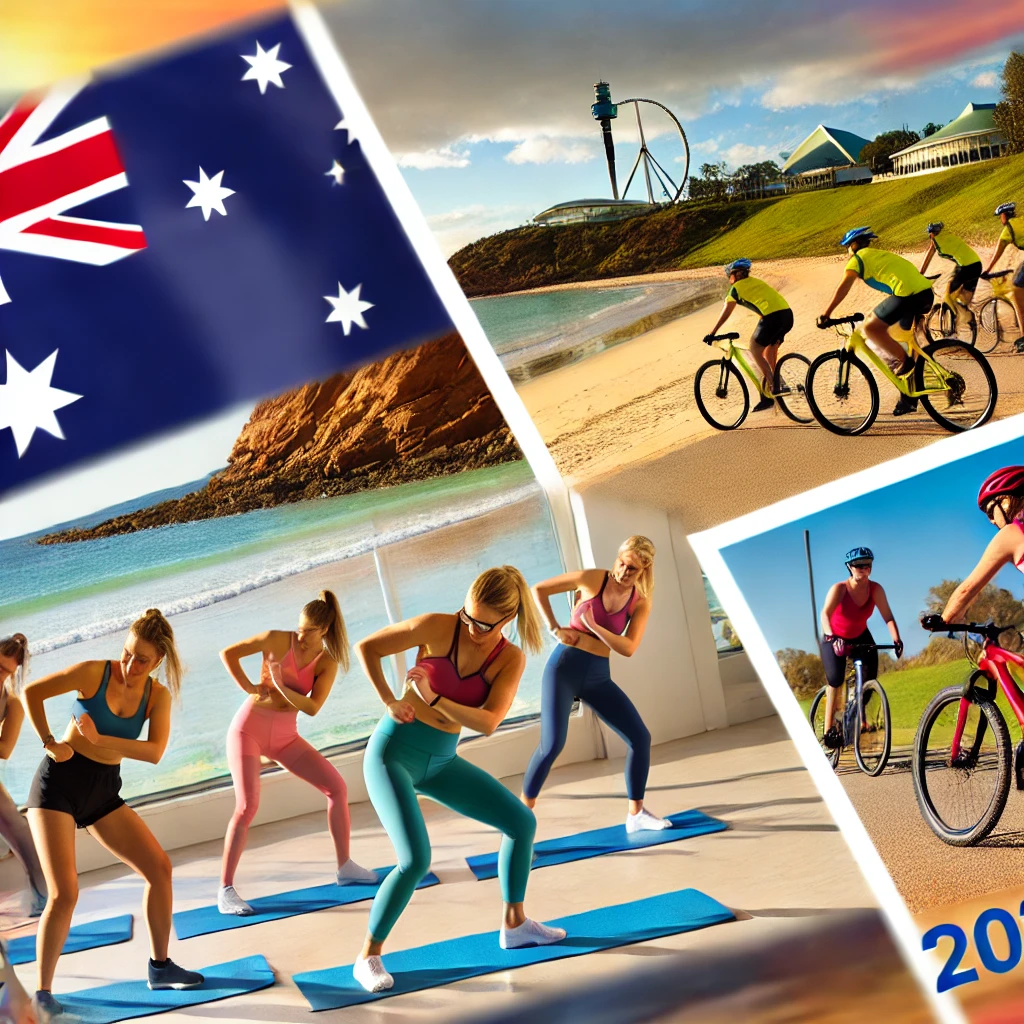Table of Contents
Introduction to Fitness Trends in 2024
The evolving fitness landscape in Australia for 2024 is a dynamic arena marked by significant transformations. To stay ahead in the pursuit of health and wellness, embracing the latest fitness trends is essential. The fitness industry, inherently adaptive, continues to reflect broader societal shifts and technological advancements, signifying more than just a focus on exercise. Today, it’s a comprehensive approach that intertwines physical activity with mental and emotional well-being.
One major force propelling these trends is the remarkable progress in technology. Innovations such as wearable fitness tech, AI-driven personalized workout regimes, and virtual reality fitness experiences are reshaping how Australians engage in physical activity. These advancements make fitness more accessible, customizable, and enjoyable for a diverse range of individuals.

Shifts in health priorities also play a crucial role in shaping the fitness landscape. There’s a noticeable move towards proactive health management, where the focus has broadened from merely addressing fitness goals to encompassing overall wellness. This shift is evident in the growing preference for fitness programs that integrate stress management, mental health support, and nutrition guidance.
Additionally, there’s an increased emphasis on holistic wellness, which promotes a balanced lifestyle and interconnected approach to health. This perspective is not just about performing workouts but also about nurturing one’s mental and emotional health. Australians are increasingly recognizing the importance of self-care practices, mindfulness, and relaxation techniques as integral elements of their fitness routines.
As we delve deeper into 2024, it’s clear that the fitness trends emerging in Australia are a testament to the progressive nature of the industry. They reflect a society that values innovation, inclusivity, and comprehensive well-being. The ensuing exploration of these specific trends will unfold the various ways in which Australians are redefining fitness to align with contemporary lifestyle demands and aspirations.
Wearable Fitness Technology
Wearable fitness technology has seen transformative progress, redefining how Australians engage with their fitness routines in 2024. With advancements in devices such as smartwatches, fitness trackers, and intricate health-monitoring tools, these gadgets offer a suite of sophisticated features that enhance their user experience. Modern fitness wearables now include capabilities like real-time data tracking, allowing users to monitor metrics such as heart rate, calories burned, and sleep quality with unprecedented accuracy.
In addition, these devices have evolved to provide personalized workout recommendations, tailoring exercises to individual fitness levels and goals. This is particularly beneficial for Australians who are keen on optimizing their fitness regimes. For instance, wearable technology can suggest specific routines, modify intensity levels, and even offer recovery tips based on real-time biometric feedback. This nuanced level of personalization is made possible through advanced algorithms and robust integration with other health apps, which collect and analyze data for informed recommendations.
The integration with health apps also adds a layer of connectivity, creating a holistic approach to health and wellness. Users can sync their wearables with various apps to track nutrition, stress levels, and even mental well-being, resulting in an all-encompassing health management system. The convenience and comprehensive insight offered by these devices are why Australians are increasingly embracing them. Wearable fitness technology is no longer just a trend; it is becoming an integral part of daily fitness practices across the country.
Moreover, the impact of these gadgets extends beyond just individual fitness routines. They foster a communal environment of shared goals and collective motivation. Fitness challenges, community leaderboards, and social sharing features help build a supportive network, enhancing adherence to fitness goals and making the pursuit of health enjoyable. As wearable technology continues to evolve, it is clear that it will play a central role in shaping the fitness trends in Australia in 2024.
Virtual and Online Fitness Classes
As we advance into 2024, the landscape of fitness in Australia is experiencing a significant shift towards virtual and online classes. This trend, gaining substantial popularity, is revolutionizing how Australians approach their fitness routines. Platforms offering live and on-demand classes have made exercising more accessible, allowing individuals to participate from the comfort of their homes or any preferred location. This surge in adoption can be attributed to the unparalleled convenience and broader range of options available online.
The variety of workout formats online caters to diverse fitness preferences and goals. From the calming and restorative practices of yoga and Pilates to the intensity of high-intensity interval training (HIIT) and the dynamic energy of dance workouts, there is something for everyone. Users can easily find classes that meet their specific needs, ensuring a tailored and effective fitness experience.
Notable players in the Australian virtual fitness market include platforms like Les Mills On Demand, Centr, and Keep it Cleaner. These companies offer extensive libraries of workout classes and are continuously enhancing user experiences through interactive and community-building features. For instance, live classes often incorporate real-time feedback, fostering a sense of participation and motivation. Additionally, social elements such as online forums, progress tracking, and challenges cultivate a supportive community atmosphere, further engaging users.
The trend toward virtual fitness is expected to grow as technology advances and more people recognize the benefits of online fitness classes. The integration of advanced features like virtual reality (VR) workouts, personalized AI-driven coaching, and the incorporation of wearable technology for real-time monitoring are transforming the way Australians stay fit. These innovations not only increase the appeal of virtual workouts but also offer an enriched fitness journey.
In embracing virtual and online fitness classes, Australians are reaping the benefits of flexibility, variety, and community, making 2024 a pivotal year for this evolving fitness trend.
Holistic Health and Wellness Approaches
In 2024, an intriguing shift towards holistic health and wellness is taking the fitness scene in Australia by storm. This progressive approach underscores the profound interconnection between the mind, body, and spirit. Australians are increasingly embracing a more comprehensive regimen that incorporates practices such as meditation, mindfulness, and nutritional therapy alongside their conventional fitness routines.
Mindfulness and meditation, for instance, have become pivotal in fostering mental clarity and emotional resilience. Yoga studios and wellness retreats around the country are witnessing a surge in attendance as individuals seek to find balance and inner peace. This trend is particularly significant in urban areas where the fast-paced lifestyle often fuels stress and anxiety. By integrating mindfulness practices, many Australians are achieving a more balanced lifestyle, which enhances their overall well-being.
Simultaneously, nutritional therapy is gaining momentum as an essential complement to physical exercise. Qualified nutritionists and dietitians are collaborating with fitness centers to provide tailored dietary plans that support specific health goals. This synergy between nutrition and physical activity underscores the idea that true fitness is more than just physical strength; it’s about nourishing the body with the right foods to fuel a holistic lifestyle. Tailored nutritional programs are now becoming staples in many fitness regimes, helping individuals optimize their diet for improved energy levels and overall health.
Prominent holistic wellness centers such as Gwinganna Lifestyle Retreat and Billabong Retreat are leading the charge by offering integrated programs that combine physical activity, mental relaxation, and nutritional guidance. These centers provide a haven for those seeking a more rounded approach to health, reinforcing the principle that sustained well-being stems from a harmonized mind and body.
The rise of holistic health and wellness not only reflects a transformative trend within Australia’s fitness landscape but also highlights a growing awareness about the necessity of a balanced, integrated approach to health. As Australians continue to prioritize comprehensive wellness practices, this trend promises to redefine the future of fitness in Australia.
Functional Fitness and Mobility Training
Functional fitness and mobility training have gained substantial traction in Australia as part of the emerging fitness trends of 2024. Emphasizing exercises that mimic everyday movements, this trend aims to improve overall physical functionality, making daily tasks easier and more efficient. This kind of training focuses on strengthening multiple muscle groups simultaneously, which enhances strength, flexibility, and balance.
The rise of functional fitness has paved the way for exercises that are designed to target core stability and joint mobility, thereby playing a crucial role in injury prevention. Unlike traditional gym workouts that often isolate specific muscles, functional fitness engages the whole body. This holistic approach not only results in improved muscle coordination but also leads to better posture and reduced pain, particularly in the lower back and knees.
Popular workouts within this trend include kettlebell training and resistance band exercises. Kettlebell workouts, for instance, are highly effective in developing muscle strength and cardiovascular endurance. Exercises such as kettlebell swings, Turkish get-ups, and goblet squats integrate multiple muscle groups and joints, promoting greater mobility and functional strength.
Resistance band exercises complement this by providing scalable resistance suitable for all fitness levels. Whether through upper-body exercises like band-resisted push-ups and rows or lower-body movements such as banded squats and leg presses, these tools help improve muscular endurance and flexibility without putting undue strain on the joints.
Bodyweight movements are another cornerstone of functional fitness and mobility training. Exercises like push-ups, planks, and lunges require no equipment and can be performed anywhere, making them accessible and convenient. These movements are excellent for enhancing body control and balance, which are essential for daily activities like climbing stairs, lifting objects, or even maintaining a good posture.
As Australians increasingly seek fitness solutions that offer durability and sustainability, functional fitness and mobility training stand out as versatile and effective methods for achieving comprehensive physical health in 2024. The benefits of such a balanced and integrated approach are reflected in improved everyday performance, fewer injuries, and a healthier lifestyle overall.
Outdoor and Adventure Fitness Activities
In 2024, Australia is witnessing a significant surge in the popularity of outdoor and adventure fitness activities. Australians are increasingly drawn towards integrating their love for the great outdoors with their fitness routines. Activities such as hiking, trail running, rock climbing, and various water sports are becoming favorite pastimes, creating a dynamic intersection between physical exercise and the natural environment.
Hiking remains one of the leading outdoor activities. It offers a versatile form of exercise that can be enjoyed by people of all fitness levels. Iconic trails such as the Overland Track in Tasmania and the Great Ocean Walk in Victoria provide stunning backdrops for this invigorating activity. Hiking not only enhances cardiovascular health but also promotes mental well-being by reducing stress and improving mood through regular exposure to nature.
Trail running is gaining traction among fitness enthusiasts seeking an intensified experience. This sport blends the endurance of running with the challenge of uneven terrain, making it a robust workout. Areas like the Blue Mountains in New South Wales and the Dandenong Ranges in Victoria offer excellent trails, drawing runners from across the country. Engaging in trail running helps in building strength, agility, and cardiovascular endurance while providing the added benefit of scenic landscapes.
Rock climbing has emerged as a thrilling fitness trend, appealing to those looking for both physical and mental challenges. With prominent climbing spots like the Grampians in Victoria and the Glass House Mountains in Queensland, Australia boasts an array of destinations for climbers of all levels. This activity enhances full-body strength, flexibility, and problem-solving skills, making it an excellent all-around workout.
Water sports, including kayaking, surfing, and paddleboarding, continue to captivate Australians. Coastal regions such as Byron Bay and the Gold Coast are hotspots for these activities. Water sports not only provide a comprehensive workout engaging multiple muscle groups but also offer a refreshing break from conventional gym routines, leading to greater mental rejuvenation.
In essence, these outdoor and adventure fitness activities promote holistic health by combining rigorous physical exercise with the therapeutic benefits of nature. Numerous events and festivals across the country, like the Ultra-Trail Australia in the Blue Mountains and the Australian Surf Festival, further facilitate and celebrate this growing affinity for adventure fitness. As Australians embrace these trends, they are not only improving their physical fitness but also fostering a deeper connection with their natural surroundings.
Personalized Fitness Programs
The rise of personalized fitness programs is one of the most prominent fitness trends in Australia in 2024. As individuals seek to achieve more efficient and targeted results, the demand for programs tailored to individual needs and goals has surged. With advancements in artificial intelligence (AI) and machine learning, these customized workout plans are becoming increasingly precise and effective.
AI and machine learning are revolutionizing the fitness landscape by analyzing vast amounts of data to create highly personalized fitness plans. These technologies can assess an individual’s physical condition, fitness level, and preferences to generate optimal workout routines. They can also adapt these plans in real-time based on progress and feedback, ensuring continuous improvement and engagement.
Fitness apps are playing a crucial role in delivering personalized experiences. Popular apps integrate AI algorithms to monitor users’ activities, suggest exercises, and offer diet plans tailored to their goals. These digital tools provide users with the convenience of accessing their fitness plans anytime and anywhere, making it easier to stay consistent and motivated.
Personal trainers are also leveraging technology to enhance the customization of fitness programs. By using data from wearable devices and fitness apps, trainers can offer more informed guidance and adjustments to their clients’ routines. This collaboration between human expertise and technology ensures that individuals receive the most beneficial and personalized support possible.
Personalized fitness programs offer a myriad of benefits, addressing specific fitness goals with tailored strategies. For instance, someone aiming for weight loss might receive a program combining calorie-burning cardio workouts and a balanced diet plan. On the other hand, an individual focusing on muscle gain would follow a regimen emphasizing strength training and protein-rich nutrition. Furthermore, those undergoing rehabilitation could benefit from exercises designed to promote recovery while preventing further injury.
Overall, the move towards personalized fitness programs reflects a broader trend of customization in various aspects of life. As technology and human expertise continue to converge, Australians can look forward to highly efficient, enjoyable, and goal-oriented fitness experiences in 2024.
Eco-Friendly Fitness Practices
The year 2024 is shaping up to be pivotal for eco-friendly fitness practices in Australia, reflecting the country’s growing commitment to sustainability. As environmental awareness reaches an all-time high, a significant trend is the integration of green practices across the fitness industry. Gym owners, fitness enthusiasts, and equipment manufacturers alike are exploring innovative ways to minimize their environmental impact, promoting a more sustainable lifestyle.
One key development is the adoption of eco-friendly gym equipment. From treadmills designed to generate energy as you work out to stationary bikes made from recycled materials, gyms are increasingly investing in green technologies. Such initiatives not only reduce the carbon footprint of fitness facilities but also inspire individuals to think more critically about the environmental impact of their workout routines.
Another noteworthy trend is the rise of sustainable activewear. Brands are increasingly producing apparel from organic, biodegradable, or recyclable materials. These garments are designed to be durable, reducing the need for frequent replacements and thereby minimizing waste. Additionally, many companies are focusing on ethical manufacturing practices, ensuring that their production processes are environmentally friendly and fair to workers.
Moreover, eco-conscious workout routines are gaining popularity. Outdoor activities such as running, hiking, and yoga sessions in parks are being favored over intensive gym-based workouts. These activities not only offer physical benefits but also foster a deeper connection with nature, encouraging individuals to appreciate and protect their natural surroundings.
Both individuals and businesses are taking significant steps to integrate these eco-friendly practices. From using reusable water bottles and eco-friendly gym bags to supporting fitness studios that emphasize sustainability, there is a collective effort to create a greener fitness culture. The long-term benefits of such practices are substantial, offering not only environmental advantages but also fostering a healthier, more conscious society.






